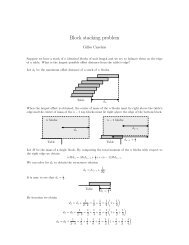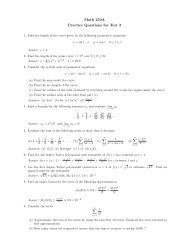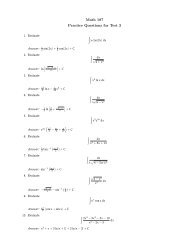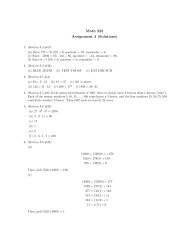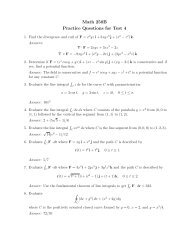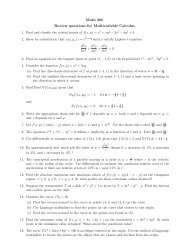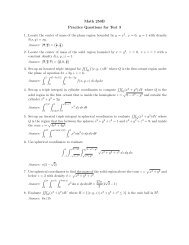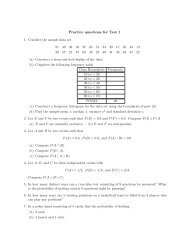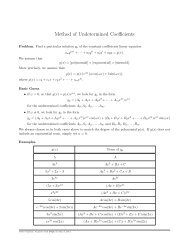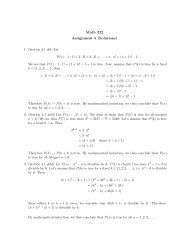Math 252 Practice Questions for Test 2
Math 252 Practice Questions for Test 2
Math 252 Practice Questions for Test 2
You also want an ePaper? Increase the reach of your titles
YUMPU automatically turns print PDFs into web optimized ePapers that Google loves.
1. Consider the differential equation<br />
<strong>Math</strong> <strong>252</strong><br />
<strong>Practice</strong> <strong>Questions</strong> <strong>for</strong> <strong>Test</strong> 2<br />
x 2 y ′′ − 3x y ′ + k y = 0, (x > 0).<br />
Find the general solution if (a) k = −5, (b) k = 4, (c) k = 13.<br />
Answers:<br />
(a) y = c 1 x 5 + c 2 x −1<br />
(b) y = c 1 x 2 + c 2 x 2 ln x<br />
(c) y = x 2 (c 1 cos(3 ln x) + c 2 sin(3 ln x))<br />
2. Find the <strong>for</strong>m of a particular solution y p in the following. (Leave your answers with undetermined<br />
coefficients.)<br />
(a) y ′′ + 4y = 5x + sin(2x)<br />
(b) y ′′ − 2y ′ + y = 3x 2 + 5xe x<br />
(c) y ′′ + 2y ′ + 5y = 3e −x + 4e −x sin(2x) − 2 cos(3x)<br />
Answers:<br />
(a) y p = Ax + B + Cx cos(2x) + Dx sin(2x)<br />
(b) y p = Ax 2 + Bx + C + x 2 (Dx + E)e x<br />
(c) y p = Ae −x + xe −x [B cos(2x) + C sin(2x)] + D cos(3x) + E sin(3x)<br />
3. Find the solution of the initial-value problem<br />
y ′′ − 4xy ′ + (4x 2 − 2)y = 0, y(0) = 1, y ′ (0) = 2<br />
given that y 1 = e x2<br />
is a solution of the equation.<br />
Answer: y = e x2 + 2xe x2<br />
4. Use the method of undetermined coefficients to find the general solution of<br />
y ′′ + y ′ − 6y = 4e 3x + 5 cos(2x).<br />
Answer: y = c 1 e −3x + c 2 e 2x + 2 3 e3x − 25<br />
52 cos(2x) + 5<br />
52 sin(2x)<br />
5. Use the method of undetermined coefficients to find the general solution of<br />
y ′′ − 5y ′ + 6y = x + 2 + 3e 2x .<br />
Answer: y = c 1 e 3x + c 2 e 2x + x 6 + 17<br />
36 − 3xe2x<br />
6. Solve<br />
y ′′ + 4y = sec(2x).<br />
Answer: y = c 1 cos(2x) + c 2 sin(2x) + 1 2 x sin(2x) + 1 4<br />
cos(2x) ln|cos(2x)|<br />
7. Use the method of variation of parameters to find the general solution of<br />
x 2 y ′′ − 2xy ′ + 2y = x 4 e −x .<br />
Simplify your answer.<br />
Answer: y = c 1 x 2 + c 2 x + xe −x (x + 2)
<strong>Math</strong> <strong>252</strong> <strong>Practice</strong> <strong>Questions</strong> <strong>for</strong> <strong>Test</strong> 2 Page 2 of 2<br />
8. Find the solution of the initial-value problem<br />
Answer: y = 2x + x ln x + x(ln x) 2<br />
x 2 y ′′ − xy ′ + y = 2x, y(1) = 2, y ′ (1) = 3.<br />
9. A mass of 2 kg is attached to a spring whose spring constant is 3 N/m. The medium offers a damping<br />
<strong>for</strong>ce of magnitude 5 times the instantaneous velocity.<br />
(a) Determine the steady-state position of the mass if it is driven by an external <strong>for</strong>ce (in Newton) of<br />
magnitude F (t) = 4 cos(2t) + 3 sin(2t).<br />
(b) Express your answer in (a) in the <strong>for</strong>m x(t) = A sin(ωt + φ).<br />
Answers:<br />
(a) x p (t) = − 2 5 cos(2t) + 1 5 sin(2t)<br />
(b) x p (t) = √ 5<br />
5<br />
sin(2t − 1.107)<br />
10. A 1 kg mass is attached to a spring with spring constant 2 N/m and a damping device with β = 3<br />
N/(m/s).<br />
(a) Find the displacement x(t) of the mass if it is released 50 cm below equilibrium with no initial<br />
velocity.<br />
(b) A <strong>for</strong>ce (in Newton) of the <strong>for</strong>m F (t) = F 0 cos t is applied to the system. Find the positive value of<br />
F 0 so that the amplitude of the steady-state solution equals 1 m.<br />
Answers:<br />
(a) x(t) = e −t − 0.5e −2t<br />
(b) F 0 = √ 10<br />
11. A mass of 1 kg is attached to a spring whose spring constant is 5 N/m. The medium offers a damping<br />
<strong>for</strong>ce of magnitude 4 times the instantaneous velocity.<br />
(a) Find the displacement x(t) of the mass if it is released 50 cm below equilibrium with an initial<br />
downward velocity of 1 m/s.<br />
(b) Find all times t > 0 when the mass passes through equilibrium position.<br />
Answers:<br />
(a) x(t) = e −2t (2 sin t + 1 2<br />
cos t)<br />
(b) t = nπ − 0.245, <strong>for</strong> all n = 1, 2, 3 . . .<br />
12. Find the first five nonzero terms of a power series solution of the initial-value problem<br />
For which values of x does the series converge?<br />
y ′′ − x 2 y ′ + 3y = 0, y(0) = 2, y ′ (0) = −1.<br />
Answer: y = 2 − x − 3x 2 + 1 2 x3 + 2 3 x4 + · · · . The series converges <strong>for</strong> all x since there is no singular<br />
point.<br />
13. Solve the differential equation: y ′′ + x 2 y ′ + xy.<br />
Answer: y = c 1 (1 − 1 6 x3 + 1<br />
45 x6 − · · · ) + c 2 (x − 1 6 x4 + 5<br />
<strong>252</strong> x7 − · · · )<br />
14. Solve the differential equation: y ′′ + e x y = 0.<br />
Answer: y = c 1 (1 − x2<br />
2 − x3<br />
6 + · · · ) + c 2(x − x3<br />
6 − x4<br />
12 + · · · )



